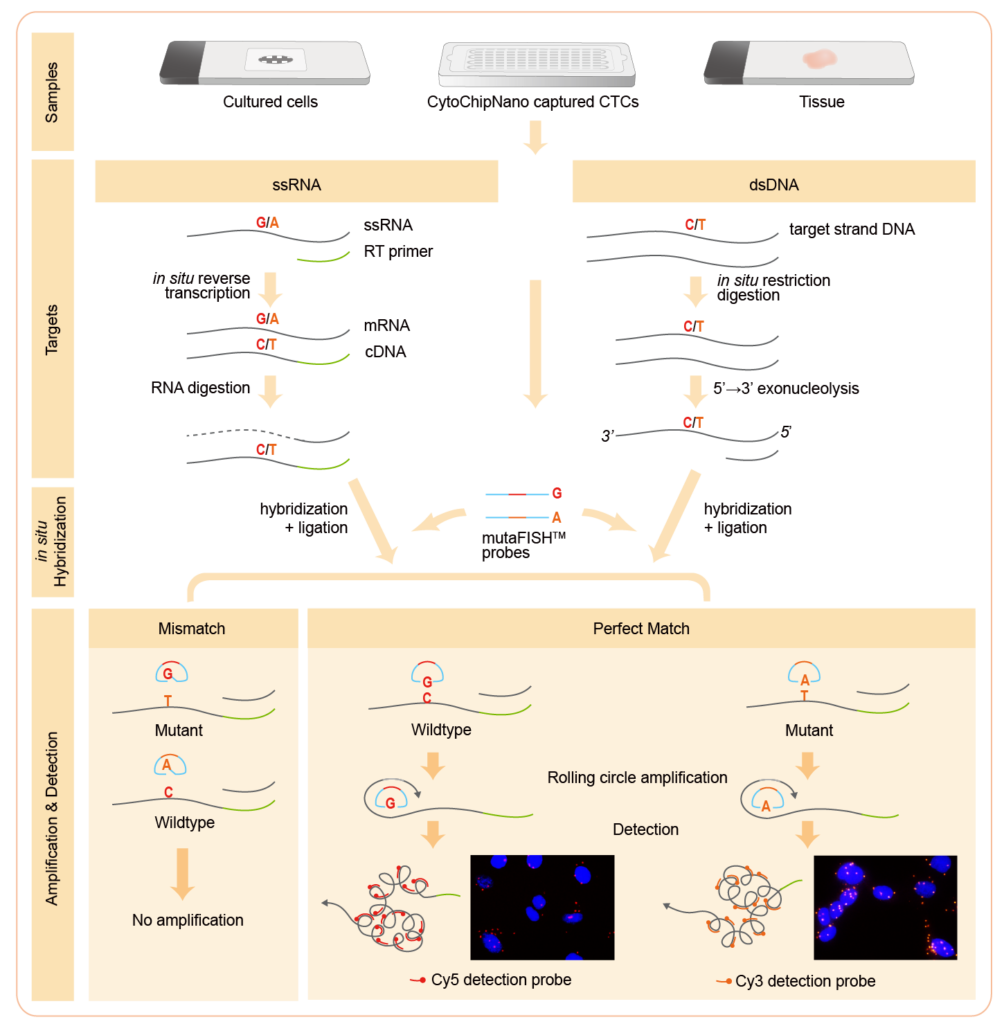Fluorescence In Situ Hybridisation (FISH)
FISH is a technique used to identify and localise the presence or absence of specific DNA sequences in cells and tissues. Abnova has developed a range of FISH probes for the detection of gene amplification, loss, and translocation. Each FISH probe product has a pair of locus-specific, fluorophore-labelled probes originating from a bacterial artificial chromosome (BAC) library.
Advantages
- Dual-coloured probes for fast, sensitive, and specific detection
- Work on metaphase spread, paraffin-embedded and frozen tissue
- Identify gene amplification, loss, and translocation
- High signal-to-noise ratio
- Low cross-reactivity
Procedure

mutaFISH™ (mutation-specific Fluorescence In Situ Hybridisation) – Single Cell, Single Molecule, DNA and RNA Mutation Detection at Single Nucleotide Resolution
The ability to interrogate cellular heterogeneity at the single cell and single molecule levels has gained increased importance. Many bioreagents and techniques exist to address this issue separately. None has the unified approach to detect and quantify DNA and RNA changes across diverse spectrum particularly point mutations and single-nucleotide polymorphisms (SNP) while maintaining their spatial context. This challenge is even greater as different analytical platforms such fluorescence, cyto/histochemistry, flow cytometry, and microfluidics are needed to study the complexity of biological states.
Abnova has integrated padlock probe and rolling circle amplification (RCA) for in situ, single cell, single molecule, DNA and RNA mutation detection at single nucleotide resolution, and obviated the technical challenges of PCR and hybridisation optimisation required for efficient and target-specific analysis. Abnova provides a growing portfolio of off-the-shelf, validated mutaFISH™ probes and accessory reagents to address the unmet needs in research and clinical settings.
Advantages
- Single Cell, Single Molecule Detection
- In situ Analysis of DNA & RNA
- Single Nucleotide Resolution
- Higher Sensitivity than dPCR and NGS
- Multiplexing Capability
- Cross Analytical Platforms
- No DNA or RNA Extraction
Technology – mutaFISH™ Workflow

Applications
- Cell In situ Hybridisation
- Circulating Tumour Cell In-situ Hybridisation
- Fresh Frozen Tissue In situ Hybridisation
- Formalin-Fixed Paraffin-Embedded Tissue In situ Hybridisation
mutaFISH™ Probes vs Conventional DNA and RNA FISH Probes
| Items | mutaFISH™ Probe | Conventional DNA FISH Probe | Conventional RNA FISH Probe |
|---|---|---|---|
| Point Mutation | Yes | No | No |
| Gene Amplification | Yes | Yes | No |
| Gene Deletion | Yes | Yes | No |
| Gene Translocation | Yes | Yes | No |
| Gene Expression | Yes | No | Yes |
FISH Probes vs mutaFISH™ Probes
| FISH Probes | mutaFISH™ Probes |
|---|---|
| Fast, sensitive and specific detection of gene amplification, loss, and translocation | Single Cell, Single Molecule, DNA and RNA Mutation Detection at Single Nucleotide Resolution |
| Advantages ● Multicolored Probes for Fast, Sensitive & Specific Detection ● Work on Metaphase Spread, Paraffin-Embedded & Frozen Tissue ● Identify Gene Amplification, Loss & Translocation ● High Signal-to-Noise Ratio ● Low Cross-Reactivity | Advantages ● Single Cell, Single Molecule Detection ● In Situ Analysis of DNA & RNA ● Higher Sensitivity than dPCR and NGS ● Multiplexing Capability ● Cross Analytical Platforms ● No DNA or RNA Extraction |

Caltag Medsystems is the distributor of Abnova products in the UK and Ireland.
